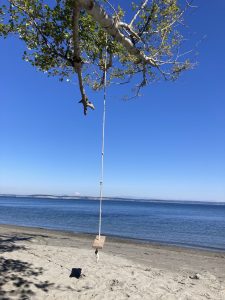No sooner did I divulge my affection for knots, that I came across this beautifully done, frankly irresistible, play thing. The setting being stunning only adds to the effect.
How was it done? What combo of knots? Such a simple thing made of a single run of rope and one piece of wood with a hole in its center. And let’s take note, this swing is made in such a way as to not harm the tree. How would you go about rigging a timeless item like this?
The single line, around half inch in diameter, has an eye spliced into one end. Ok, that part is somewhat tricky to do. But you could get a similar effect with a bowline, it’d work the same way just be a touch less elegant. The line is heaved over the branch, the two halves made equal. Then the bitter end is put through the eye, and the whole thing is tightened-up. Note that no matter how much the branch expands, the loop will hold, grow with the tree, and not choke the limb.
View from below shows the rest of the job. Handholds are formed- in this case with simple overhand knots. If you look closely you might make out there are three holds. The top and bottom are overhand knots, but the middle one is a figure eight. The maker may have realized too late that once the overhand knots tighten, they will lock- especially adding weight and weather- and it’d be practically impossible to undo. OTOH The figure eight knot, which is just an overhand with an extra twist is easily broken and comes undone, if you need to salvage the line, nbd.
The end of the line is then passed through the hole in the bench, finished with a stopper knot. In this case a jumble, but it’ll do. I might have gone with an Ashley stopper, or barrel knot to finish, mostly for the sake of bulk, but with clean looks. This stopper will do the job and stand the test of time and weight. Speaking of which, the safe limit of double braided nylon is almost half a ton. The branch will break before the line.
The deva is in the details. A little artistry, and physics, resulting in something offering a moment of peace or bliss for swingers of all ages.









An Enthralling Description
I very much appreciate the generosity of AnneODyne in taking the time and making the effort to share her detailed observations and astute comments about something which is truly remarkable, but which one might otherwise barely notice.
The right knot for the right purpose!
Knowing a variety of knots comes in handy as you can choose the best one for the job.
Some knots hold and secure, some tighten, and some stay loose.
They are made with loops, twists, ins, overs, outs and throughs. Knitters and crochet-ers still know how to do amazing things with single strand. The fish net makers down at the Brattleboro docks, too.
Let’s get hitched…
In our society those are some potent words; signaling connection, signifying endurance, and we all know there are plenty of ways to do it, as many styles and functions as there are needs…. Clove, Buntline, Rolling, Icicle, Blake’s, Mooring, Reef, Cow, Trucker’s, Midshipmen’s…like marriages some will come loose with the faintest tug, while others can belay you from the highest treetops at any chosen speed…some work in only one direction, others are made to hold whatever tension you can bring…but each form of hitch shares one thing in common…as in the promise of a nuptial proposal… ”we will not fail you, you can trust us, if you’ve done us right we won’t let go…”
A fruitful bond made by friction and pressure, one good turn deserves another.
https://www.niamhtrua.com/post/types-of-handfasting-knots
"Hitched" Means United.
Same letters, but the opposite of “Untied.”